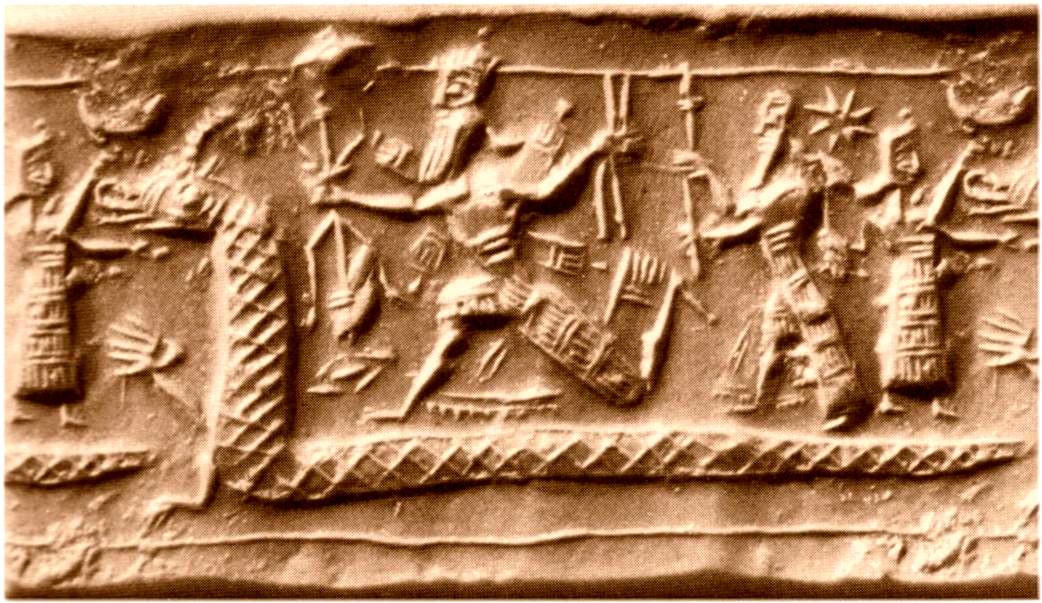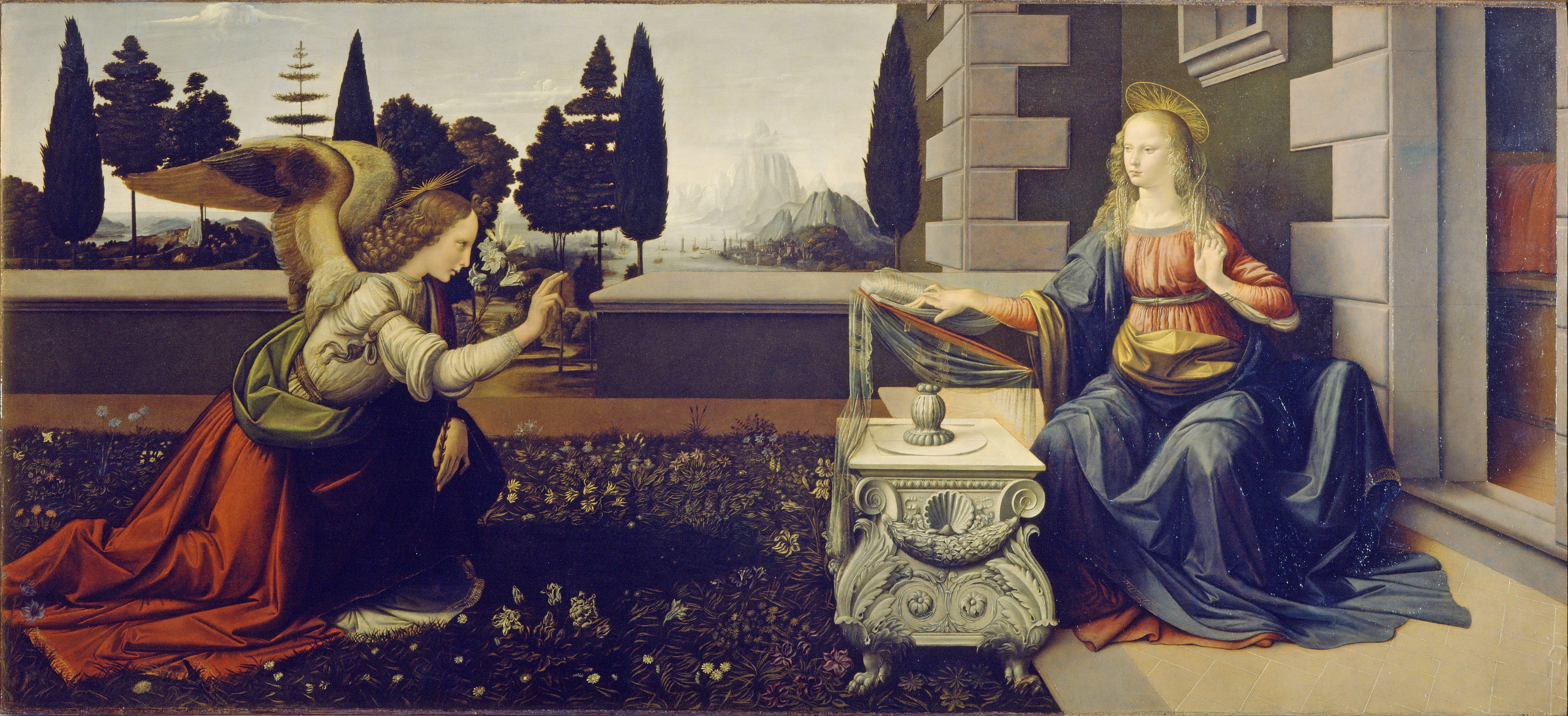 |
| William Blake - The Night of Enitharmon's Joy or The Triple Hecate, 1795 |
Although Hecate is called the goddess of witchcraft, she is much more than this. Her mythology, cults and role are definitely worth talking about as they all played an important role in ancient times. It is said that she could alter the fate of human beings by either giving wealth or taking it away, giving victory or causing death, giving good luck to hunters and sailors or, if they angered her, causing them bad luck and also by governing over the prosperity of both youth and cattle.
I will try to write a sort of biography of this goddess even though some may find it over-simplified. I won't mention ALL of the theories or interpretations but rather the most important or widely-accepted ones. Nevertheless, I hope you will find this post useful. :) If you find it interesting, I recommend you have a look at a wonderful and very professional website called Theoi Greek Mythology where you will find much more information on this deity as well as any part of Greek mythology you can think of and all of this backed up by quotations from classical authors and documents.
The Origins of the Goddess
Hecate (this is the Latin spelling of her name; in Greek it is spelled Hekatê) is believed to originally be a Thracian moon-goddess and not a Greek one. The Thracians were a group of Indo-European tribes that lived in Central and Southeastern Europe who had contact with the Greek civilization (though they were supposedly enemies). It seems as though Greece colonized the Thracians at some point in history and this is probably how Hecate and other religious and mythological figures were incorporated into Greek mythology and beliefs.
Her name is thought to have been derived from the female variation of the epithet hekatos (Worker from Afar). It is unclear as to why she was called this, though this adjective was originally ascribed to Apollo with whom she was sometimes connected to. Apollo was an archer god who was said to shoot arrows from afar (he was also the god of sudden death) so his association with the adjective is quite clear. My guess would be that she, as a huntress (who also hunted with arrows) had the same associations as Apollo when it came to this subject. Of course, other theories exist, but this is just the most widely-accepted one.
Her name is thought to have been derived from the female variation of the epithet hekatos (Worker from Afar). It is unclear as to why she was called this, though this adjective was originally ascribed to Apollo with whom she was sometimes connected to. Apollo was an archer god who was said to shoot arrows from afar (he was also the god of sudden death) so his association with the adjective is quite clear. My guess would be that she, as a huntress (who also hunted with arrows) had the same associations as Apollo when it came to this subject. Of course, other theories exist, but this is just the most widely-accepted one.
Hecate's Biography
Birth
The most widely accepted story regarding Hecate's birth is that she was the only child of the Titanes Perses and Asteria. Perses was the Titan god of destruction, while Asteria (called "the Starry Night") was the Titan goddess of oracles, prophecies, the night, astrology, dreams and so on.
The Titanes in general are pre-Olympian gods, which means that, according to Greek mythology, they ruled over heaven, earth and the underworld before Zeus and the other Olympian gods took everything into their own hands. As Hecate is the child of two Titanes, she herself is a Titan and also predates the Olympian gods.
Her Role in the Gigantomachy
 |
Hecate and the gigante Klytios, Attic
red figure vase, Antiken-museen, Berlin,
Germany, ca 410 - 400 BC (she is
depicted killing the gigante with her two torches) |
The story of the Gigantomachy is quote complicated, but I will try to sum it up. Two gods in Greek mythology are related to their origin story; these are Uranus (the Sky) and Gaia (the Earth). It is worth mentioning, though, that they were not the first gods. In any case, the pair had several children which are known to us as the Titanes. There are several generations of Titanes and both Perses and Asteria belong to the second generation, which would make Uranus and Gaia their grandparents in a way.
Gaia and Uranus weren't the best couple ever. He imprisoned her children and she sought revenge. She was able to turn the Titanes against Uranus and got the youngest of them, Kronos, to castrated him and thus kill him. In the process, some of his blood fell on the Earth (Gaia) and from it were born the Gigantes (among many others). This war between the Titanes and Uranus is known as the Titanomachy. Of course, the story doesn't end here. Before he died, Uranus, in a way, cursed Kronos by telling him that his children would overthrow him just as he had overthrown his father (Uranus).
Kronos decided to play it safe and imprisoned the Gigantes in Tartarus along with all the others that were a potential threat to his rule. He got even worse and ate all of his children, except one - Zeus. Namely, Kronos' wife Rhea barely managed to save Zeus' life by fooling Kronos into eating a rock wrapped in a blanket in stead of Zeus.
Anyway, when Zeus grew up, he tricked his father into vomiting up his brothers and sisters. He fulfilled Uranus' prophecy by rebelling against Kronos and establishing his own rule on mount Olympus. He basically defeated all the Titanes and trapped them in Tartarus.
Now we finally come to the Gigantomachy mentioned in the subtitle. Gaia wanted to restore the rule of the Titanes and was very angry at Zeus. She thus brought forth the Gigantes and went to war with Zeus and the other Olympian gods. In the end, the Olympians won with the help of Hercules, as another prophecy foresaw. The Gigantomachy was a huge mythological battle and this very very short summary does not do it justice, but it will have to do. Anyway, many gods and other mythological figures took part in it. Among them was Hecate.
Hecate apparently proved her worth in this battle by killing the gigante Clytius. Zeus rewarded her after the battle for being on the side of the Olympians, or rather he didn't take anything away from her. She, as a Titan, had a certain amount of power over the earth, sea, sky and underworld (although this is usually summed up into three realms: earth, sky and the underworld for symbolic purposes, but we'll get to that later). Zeus let her keep this power because she had proven her worth, courage and, above all, loyalty.
The Rape of Persephone - Hecate as an Infernal Deity
According to the myths, Hades (the god of the underworld) fell in love with Persephone (the goddess of the spring) and kidnapped her. Her mother Demeter searched all over for her and was help by none other than Hecate. Once again, this is only a small part of the myth, but it will do for now. While Persephone was yelling out for help as Hades was attempting to rape her/while he was kidnapping her (this differs from myth to myth), Hecate was the only one to hear her screams. Hecate joined Demeter in her search and guided her with her two torches through the dark in an attempt to save her daughter. After they found Persephone, she (Hecate) decided to stay in the underworld with her as her companion.
This is how Hecate became a deity of the underworld, although this myth can only be traced back to the time of the Greek tragedies. In any case, she was in charge of the souls of the deceased; she purified them and helped them make atonement.
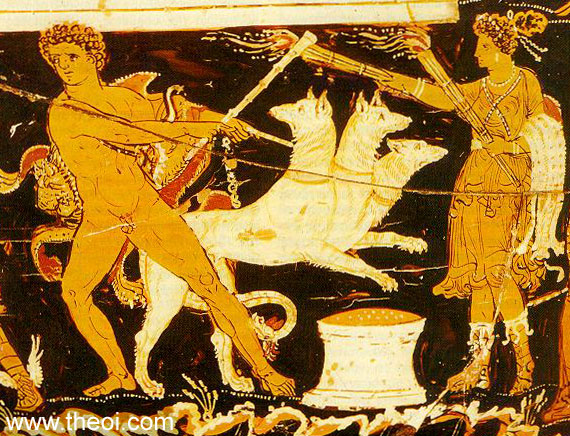 |
Hercules, Cerberus and Hecate (on the
right), Apulian red figure krater,
Antikensammlungen, Munich, Germany,
ca 330 - 310 BC
|
As Hecate lived in the lower world, she developed darker aspects (which are by no means less important or necessarily "evil"; they are just darker but regarded as equally necessary for the balance of the world as any good characteristics any god may possess). She became associated with ghosts and other beings of the underworld (which she supposedly sent to earth during the night). Sometimes she would go along with them and her presence could supposedly be known because dogs would start to howl. Her association with dogs is quite deep as she was usually accompanied by the hound Cerberus who lived in the underworld with her. She also had another dog companion; a black bitch who was actually the Trojan Queen Hekabe (the queen had jumped into the sea after the fall of Troy in the Trojan War or was stoned to death according to some myths, but the gods turned her into a black dog and gave her as a gift to Hecate).
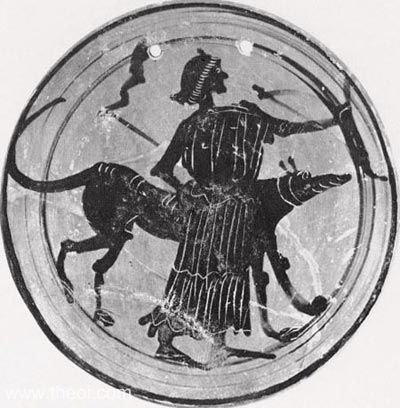 |
Hecate with a black dog,
Antiken-sammlung des Archaologischen
Insituts der Universitat,
Eberhard-Karls Universitat,
Tubingen, Germany,
Attic black figure kylix
|
As she was very close to Persephone, she became identified with her. Unfortunately, as an infernal deity (a deity of the lower world), many negative associations were developed with her. She came to be seen as malevolent and was said to practice witchcraft by which she controlled the many spirits of the underworld. According to some sources, she had complete control over the lower world and everything in it.
Since it was believed that spirits haunted crossroads (and Hecate was often with these spirits), she became known as the goddess of crossroads too.
All of this lead to Hecate being seen as the goddess of the underworld, of the night (as she and the ghosts were thought to come out at night), consequently of ghosts and spirits and the Moon, but also as the goddess of magic and witches. And so she became the Greek "goddess of witchcraft". Also, her association with the Moon is another reason why she is often confused with Persephone.
Medea, Kirke and Gale - Witches and Hecate
There are several myths connecting Hecate to witches and witchcraft (although these are not the only reasons why Hecate is associated with witchcraft).
The first myth is that of the witch Medea who was also a priestess of the goddess. In most stories, it is said that Medea got her magical powers from Hecate. This is logical as Medea dealt with ghosts and spirits (i.e. her magic was necromantic in a way) and Hecate herself was the goddess of the underworld.
Also, according to some myths, both Medea and Kirke were Hecate's daughters (though she is usually said to be a virgin goddess). In fact, she taught both her daughters all she knew about witchcraft, herbs and such (in particular poisonous herbs which were her specialty). Kirke especially followed in her mother's herbologist footsteps.
As for Gale, she was also a witch that completely lacked self-restraint. This referred to her sexual appetite, but it is not clear whether it also referred to her magic as well. In any case, this angered Hecate who punished her by turning her into a polecat that was from then on her familiar (along with the black dog I mentioned before).
Hecate's connection with witchcraft does not end here. Hesiod explains that she is a nocturnal goddess of witchcraft because of her parentage (Asteria was the goddess of stars and the night and her father's name - Perses - is linguistically connected to both Persephone, the goddess of the underworld, and Perseis, the mother of Kirke and another witch called Aeetes, although this second association is quite blurred as Hecate is also referred to as Perseis, because she has different relations with Aeetes in other myths and so on). Another reason why she is connected to witchcraft is because of her connection to necromancy. This association was inevitable as Hecate was connected to ghosts (and necromancy is the practice of communicating with the dead). And just to repeat this once more, her supposed daughter Medea was thought to practice precisely this kind of magic. It is partially due to this myth (and others similar to it) that witches in general came to be associated with the practice and so Hecate also god mixed into the stereotype.
I already mentioned that Hecate was very skilled when it came to herbs, especially poisonous ones. Herbology was a traditional practice among witches to say the least, and being acquainted with poisonous plants was all the more necessary as some of them could also be used for healing. On the other hand, one must know a poison to know the cure. Herbology was often accompanied by magic which only serves as an additional connection between Hecate and witchcraft. It can thus be said that Hecate is also the goddess of magic and poisonous herbs (or herbology in general).
Hecate as the Triple Goddess
 |
| Triple-formed representation of Hecate, marble, Roman copy after an original of the Hellenistic period |
The reason why many Wiccans and witches alike respect or worship Hecate, apart from the fact that she is the goddess of witchcraft, is that she is also referred to as the Triple Goddess. As many of you may know, the Wiccan Goddess is perceived as a Triple Goddess with three aspects; the Maiden, Mother and the Crone.
Hecate got this title as a consequence of being a crossroads deity. Namely, she presided over the areas where three roads met and was thus depicted as watching in all three directions simultaneously. This lead to her being perceived either as three aspects of the same goddess turned back to back to one another or as a goddess with three heads. As mythology goes, these heads weren't always human; one head was often that of a horse, the other of a lion (or a boar) and the third of a dog (recall her association with dogs).
 |
| Hecate, the British Museum |
Another reason why she is depicted as a triple goddess is because she had power over all three realms - the earth, underworld and the sky (if you remember, Zeus didn't take these powers away from her as a thank-you for her helping him in the battle of the Gigantes). The one difference between Hecate's triplicity and that of the Wiccan Triple Goddess is that all three faces/bodies of Hecate are usually portrayed as young and beautiful, whereas the Wiccan Triple Goddess has three aspects out of which only the Maiden can be called young. The Mother aspect is slightly older, though no less beautiful, and the Crone aspect...well...the name speaks for itself.
The Romans referred to her as Diana Triformis (i.e. Diana of Three Forms). Diana was the Roman equivalent of the Greek goddess Artemis with whom Hecate is also connected. In this case, she was truly a goddess with three separate aspects; that of the goddess Diana (the Greek Artemis), Hecate and Prosperina (i.e. the Greek Persephone which we already established a connection to).
Since we are on this topic, it is worth emphasizing that Hecate was often confused with both Persephone and Artemis. The reasons why she was confused with Persephone are: (1) they are both deities of the underworld (and they are very close); (2) they are both carriers of the souls of the dead; (3) the torch is a symbol of both of them.
The reasons for her confusion with Artemis are the following: (1) they are both depicted wearing knee-length dresses and boots; (2) they are both often depicted being followed by dogs; (3) they are both said to love hunting (and Artemis was the goddess of the hunt); (4) they were both protectors of the youth; (5) they were both thought to be virgin goddesses; (6) linguistic mix-ups and confusing ideas connected to the Persephone myth; (7) they are both lunar deities.
Another goddess that Hecate is often confused with is Selene since both are lunar goddesses and are ultimately connected to the night and stars also.
Hecate's Iconography
Iconography is the study of the use of symbols (or icons) in works of art which are used to interpret the meanings of the works themselves. Hecate, as any mythological figure, is associated with certain things and other figures. It is precisely by means of these associations that interpreters can recognize her figure in an artwork.
Hecate's main symbols are:
- two torches (sometimes only one; this developed from the myth of the rape of Persephone)
- her familiars - the polecat and a black bitch
- dogs in general (her black dog familiar, the dog Cerberus, she is sometimes depicted with a dog's head, dogs start howling when she is present, she is sometimes accompanied by a pack of dogs just as Artemis is etc.)
- keys (she unlocks the mysteries of the underworld)
- daggers (she uses them to "cut through delusions", this is also often associated with the Wiccan ritual knife known as the athamé)
- knee-length maiden's skirt and hunting boots (typical dress of virgin goddesses; also part of the reason why she is confused with Artemis)
Although she is not depicted with the following symbols, they are still connected to her:
- the Moon
- the night
- the underworld
- ghosts/spirits
- crossroads
- magic/witchcraft/witches
Hecate's Cult
Even though Hecate was a well-known goddess in the ancient world, she was not worshiped publicly as much as she was privately. Her worship was mainly conducted at small, private altars in the home. It was thought that having such an altar in the household would ward off the evil eye and other hexes or curses (or negative influences of witchcraft in general).
As she was a deity of the crossroads, a sort of "crossroad shrines" also existed. These were more gifts or sacrifices (usually of food) that were placed on the crossings of three roads as is appropriate for this triple deity.
Her public cult was the strongest in Eleusis (Attika, Southern Greece) where the famous Mysteries of Eleusis were dominant. These mysteries primarily celebrated the goddesses Persephone and Demeter as goddesses of fertility and crops. The myth of Persephone's abduction and rape was surely a part of these mysteries and so Hecate, by extension, was also included. It seems as though her cult was in general very strong in the south of Greece, not only in Eleusis but also the cities of Athens, Aigina, Argos and so on.
I previously mentioned that she was a Thracian goddess also. Some claim that she herself was not this specific Thracian goddess but rather that she was equated with the goddess Bendis. This would mean that Hecate was simply a product of the synchronicity of the Greek and Thracian culture and took on Bendis' attributes. As Thracia was situated north of Greece, her cult was also present in the northern regions of the land such as Thessaly.
In addition to Eleusis, her cult was also very strong on the island of Samothrace and could also be found in Asia Minor and even on the island of Sicily in southern Italy.
Her cults gave her many names and epithets. Most of them were connected to her characteristics, mythology or parentage. So just to list a few: Perseis (the Destroyer; named after her father Perses who was the Titan god of destruction), Aidônaia (Lady of the Underworld; she was an infernal deity as mentioned before), Trimorphis (Three-Formed, she was depicted as having three heads or three bodies each facing a different direction), Trioditis (of the Crossroads or of the Three Ways, she was the goddess of the crossroads and also a triple goddess), Nytipolos (night-wandering, she was a nocturnal deity), Khthoniê (of the Underworld, as explained before), Skylakagetis (Leader of the Dogs; she was associated with many dogs, some of which were her familiars), Liparokrêdemnos (Bright-Coiffed, With Bright Headband, can be connected to her being a lunar deity), Anassa eneroi (Queen of those Below or Queen of the Dead as she was the goddess of the Underworld) and so on.
Hecate gained a sort of bad reputation because of her connection to witchcraft (just as witchcraft itself gained an even worse reputation). This can be traced back to the Middle Ages when she was seen as presiding over the "satanic rituals" that witches conducted. Hah. More precisely, it was Diana that was believed to lead these rituals, but Diana and Hecate were very closely connected and even equated sometimes. An interesting theory is that Hecate's triplicity (or rather her depiction with three heads) lead to Dante's description of a three-faced Satan.
Many have a hard time connecting with Hecate and some even fear her image, but this is all due to prejudice and misconceptions. Even though this deity has many darker aspects, it is important to remember that she is not all dark. Even the "nicest" of gods have dark aspects. I believe that modern society is just used to everything being purely good or bad or black and white and that ambivalence of deities such as were worshiped by the ancients is incomprehensible. The ancients saw the deities as very anthropomorphic. As such, they had their own backgrounds, relations, characteristics and, what's more important, they were not perfect! Each of them differed from one another and in every situation, someone had to be the bad guy and someone had to be the good guy. As is the case in real life, it's not always the same people that play the role of the good guy; everyone shows their "bad side" every now and then. It was the same with the gods.
One must remember that Hecate also has many "neutral" and positive associations. Also, things that we see as "bad" nowadays are a misconception from the viewpoint of the ancients. For instance, the underworld would not have been seen as bad back then; it was an equally necessary part of the cosmos as anything else and thus was important for keeping a cosmic balance. The same can be said of the night; one person may have very bad associations with it while another may perceive it as beautiful and enchanting, or even romantic. This is why I believe that even the so called "dark" gods must be given a chance and tried to be seen without prejudice and from other perspectives.
Until next time. Yours,
Witch's Cat
As she was a deity of the crossroads, a sort of "crossroad shrines" also existed. These were more gifts or sacrifices (usually of food) that were placed on the crossings of three roads as is appropriate for this triple deity.
Her public cult was the strongest in Eleusis (Attika, Southern Greece) where the famous Mysteries of Eleusis were dominant. These mysteries primarily celebrated the goddesses Persephone and Demeter as goddesses of fertility and crops. The myth of Persephone's abduction and rape was surely a part of these mysteries and so Hecate, by extension, was also included. It seems as though her cult was in general very strong in the south of Greece, not only in Eleusis but also the cities of Athens, Aigina, Argos and so on.
I previously mentioned that she was a Thracian goddess also. Some claim that she herself was not this specific Thracian goddess but rather that she was equated with the goddess Bendis. This would mean that Hecate was simply a product of the synchronicity of the Greek and Thracian culture and took on Bendis' attributes. As Thracia was situated north of Greece, her cult was also present in the northern regions of the land such as Thessaly.
In addition to Eleusis, her cult was also very strong on the island of Samothrace and could also be found in Asia Minor and even on the island of Sicily in southern Italy.
Her cults gave her many names and epithets. Most of them were connected to her characteristics, mythology or parentage. So just to list a few: Perseis (the Destroyer; named after her father Perses who was the Titan god of destruction), Aidônaia (Lady of the Underworld; she was an infernal deity as mentioned before), Trimorphis (Three-Formed, she was depicted as having three heads or three bodies each facing a different direction), Trioditis (of the Crossroads or of the Three Ways, she was the goddess of the crossroads and also a triple goddess), Nytipolos (night-wandering, she was a nocturnal deity), Khthoniê (of the Underworld, as explained before), Skylakagetis (Leader of the Dogs; she was associated with many dogs, some of which were her familiars), Liparokrêdemnos (Bright-Coiffed, With Bright Headband, can be connected to her being a lunar deity), Anassa eneroi (Queen of those Below or Queen of the Dead as she was the goddess of the Underworld) and so on.
Hecate gained a sort of bad reputation because of her connection to witchcraft (just as witchcraft itself gained an even worse reputation). This can be traced back to the Middle Ages when she was seen as presiding over the "satanic rituals" that witches conducted. Hah. More precisely, it was Diana that was believed to lead these rituals, but Diana and Hecate were very closely connected and even equated sometimes. An interesting theory is that Hecate's triplicity (or rather her depiction with three heads) lead to Dante's description of a three-faced Satan.
Many have a hard time connecting with Hecate and some even fear her image, but this is all due to prejudice and misconceptions. Even though this deity has many darker aspects, it is important to remember that she is not all dark. Even the "nicest" of gods have dark aspects. I believe that modern society is just used to everything being purely good or bad or black and white and that ambivalence of deities such as were worshiped by the ancients is incomprehensible. The ancients saw the deities as very anthropomorphic. As such, they had their own backgrounds, relations, characteristics and, what's more important, they were not perfect! Each of them differed from one another and in every situation, someone had to be the bad guy and someone had to be the good guy. As is the case in real life, it's not always the same people that play the role of the good guy; everyone shows their "bad side" every now and then. It was the same with the gods.
One must remember that Hecate also has many "neutral" and positive associations. Also, things that we see as "bad" nowadays are a misconception from the viewpoint of the ancients. For instance, the underworld would not have been seen as bad back then; it was an equally necessary part of the cosmos as anything else and thus was important for keeping a cosmic balance. The same can be said of the night; one person may have very bad associations with it while another may perceive it as beautiful and enchanting, or even romantic. This is why I believe that even the so called "dark" gods must be given a chance and tried to be seen without prejudice and from other perspectives.
Until next time. Yours,
Witch's Cat





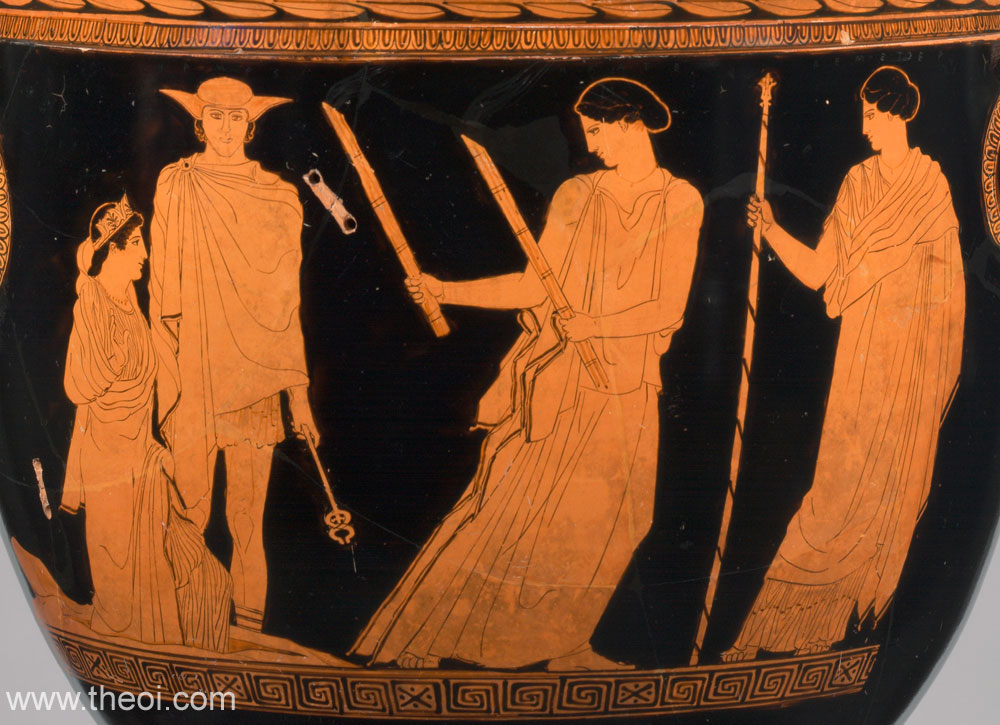











_-_Francisco_de_Goya_y_Lucientes.jpg)










